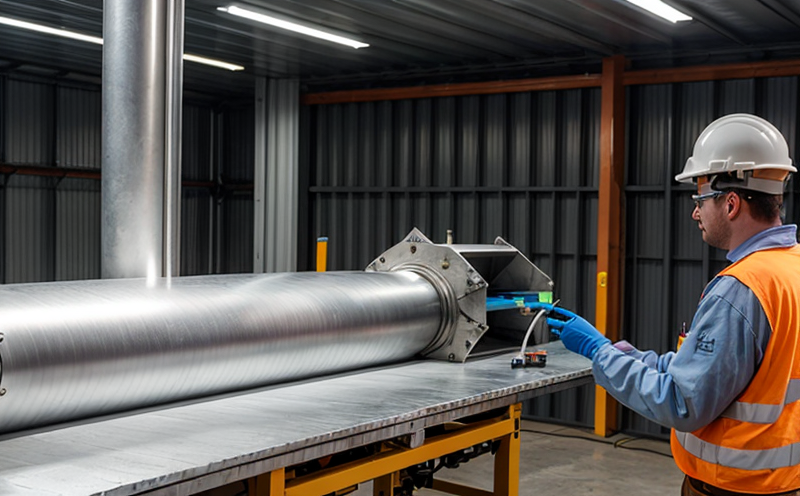ASTM G48 Pitting and Crevice Corrosion Testing of Stainless Steel Components
The ASTM G48 standard is a critical tool in the evaluation of stainless steel components used in renewable energy applications. This testing method specifically targets pitting and crevice corrosion, which are significant concerns for materials operating in harsh environments such as wind turbines, solar power systems, and marine structures.
Pitting and crevice corrosion can lead to premature failure of critical components, resulting in costly downtime and operational inefficiencies. The ASTM G48 test provides a standardized approach to evaluating the resistance of stainless steel to these forms of localized corrosion. By subjecting specimens under controlled conditions that mimic real-world operating environments, this testing ensures that materials meet stringent performance criteria before deployment.
The process involves exposing a sample of the stainless steel component to an environment designed to promote pitting and crevice formation. The test specimen is typically maintained in a solution containing chloride ions, which are known to accelerate these types of corrosion. The duration of exposure varies depending on the specific requirements of the project or regulatory standards.
During testing, close monitoring of the sample allows for precise measurement of any pitting or crevice formation. This data provides valuable insights into the material's resistance and helps in optimizing design parameters to enhance durability and longevity. Compliance with ASTM G48 not only ensures adherence to industry best practices but also demonstrates a commitment to quality and reliability.
The results from this testing are crucial for selecting appropriate materials that can withstand the rigors of renewable energy applications, thereby enhancing operational efficiency and reducing maintenance costs. This standardized approach fosters trust among stakeholders and contributes significantly to the overall success of projects involving stainless steel components in these sectors.
In summary, ASTM G48 is an essential test method for assessing pitting and crevice corrosion resistance in stainless steel used in renewable energy applications. It provides a reliable framework for quality control and ensures that materials meet or exceed industry standards, thereby supporting the development of robust and sustainable technologies.
Industry Applications
The ASTM G48 testing method finds extensive application across various sectors within renewable energy, where stainless steel components are subjected to challenging environmental conditions. Key areas include:
- Wind Turbines: Blades and structural components must endure extreme weather conditions, including salt spray, which can lead to pitting and crevice corrosion.
- Solar Power Systems: Modules and mounting structures may be exposed to corrosive elements in harsh climates, requiring robust materials that pass the ASTM G48 test.
- Tidal Energy Devices: Piping systems and other components must resist saltwater corrosion, making this testing crucial for ensuring longevity and reliability.
- Solar Water Heating Systems: Components such as heat exchangers often need to withstand aggressive water environments, necessitating thorough evaluation of their resistance to localized corrosion.
The ASTM G48 test is particularly important in these applications because it simulates the specific environmental conditions that components are likely to encounter. This ensures that materials and designs meet the necessary performance criteria, ultimately contributing to safer and more efficient renewable energy systems.
Quality and Reliability Assurance
The ASTM G48 test plays a vital role in quality assurance programs by providing a standardized method for evaluating pitting and crevice corrosion resistance. This ensures that materials used in renewable energy applications meet stringent performance criteria, enhancing overall reliability.
By subjecting specimens to controlled environmental conditions, the test identifies any weaknesses or vulnerabilities in the material before it is deployed in real-world applications. This early detection allows for corrective actions to be taken during the development phase, ensuring that only high-quality materials are used in production.
The results from the ASTM G48 test provide valuable data on the performance of stainless steel components under specific conditions. This information can guide further improvements in material selection and manufacturing processes, leading to enhanced durability and longevity of renewable energy systems. Additionally, compliance with this standard demonstrates a commitment to quality and reliability, building trust among stakeholders.
In conclusion, the ASTM G48 test is an integral part of any comprehensive quality assurance program for stainless steel components used in renewable energy applications. It ensures that materials meet or exceed industry standards, thereby supporting the development of robust and sustainable technologies.
International Acceptance and Recognition
The ASTM G48 test is widely recognized and accepted across various international jurisdictions due to its rigorous methodology and consistency in results. This standard is particularly valued for its ability to provide a standardized approach to evaluating pitting and crevice corrosion resistance, which are critical concerns in the renewable energy sector.
Many countries have adopted ASTM G48 as part of their regulatory frameworks for materials used in wind turbines, solar power systems, and other renewable energy applications. This international recognition ensures that testing results are consistent and comparable across different regions, facilitating global collaboration and trade.
The standard is referenced in numerous industry guidelines and codes, including ISO 12944, which provides a comprehensive approach to corrosion protection of ferrous and non-ferrous materials. ASTM G48 aligns closely with these international standards, further enhancing its credibility and acceptance worldwide.
Compliance with the ASTM G48 test is not only beneficial for ensuring material quality but also supports regulatory compliance in diverse geographic locations. This global recognition fosters a unified approach to quality control, promoting consistency in testing methods and results across different markets.





